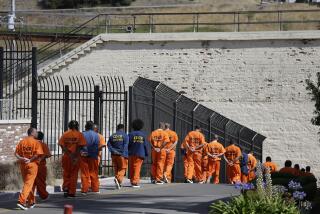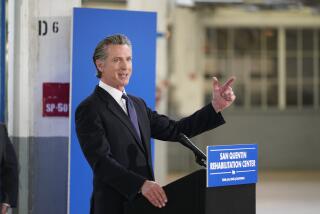Californians would go further than Gov. Brown to cut prison crowding
SACRAMENTO — Most California voters are willing to take more drastic steps than Gov. Jerry Brown favors to reduce prison crowding, including the early release of nonviolent offenders, but they don’t want to sacrifice public safety to reduce the inmate population, according to a new poll.
Support for softened penalties comes as Brown is fighting an order from a panel of federal judges to continue shrinking the number of inmates in state prisons. He says California has done enough and any more changes could increase crime.
Sixty-three percent of voters in the poll by the USC Dornsife College of Letters, Arts and Sciences and the Los Angeles Times said they favored releasing low-level, nonviolent offenders from prison early. Brown has opposed using such releases to comply with the court’s order to remove 9,500 inmates by the end of the year. Thirty-one percent were opposed.
An even higher share of voters, 72%, were comfortable with reducing sentences for minor crimes, another possible outcome of the court order.
The poll results underscore an ongoing shift away from the tough-on-crime measures that California helped pioneer two decades ago with its “three strikes” law. Last year, voters overwhelmingly approved a ballot measure to loosen the law so that many nonviolent crimes don’t trigger the harshest prison sentences.
State prisons are under federal oversight because the judges say overcrowding prevents inmates from receiving adequate medical care, resulting in unconstitutional conditions and even unnecessary deaths. Brown has appealed the judges’ order to the U.S. Supreme Court.
If that fails, the governor says, he is willing to keep paying private prisons to hold inmates out of state or have counties incarcerate more offenders. However, that would still leave state prisons with thousands more inmates than permitted under the court order.
The governor’s handling of the state prison system also has come under political attack from a likely Republican challenger in next year’s election, former Lt. Gov. Abel Maldonado.
Maldonado has warned that the core of Brown’s current strategy, keeping more low-level offenders in county jails rather than sending them to state prisons, is dangerous. He has expressed interest in more prison construction.
But the poll suggests the public favors Brown’s approach, with 74% of voters saying they support shifting responsibility for some felons to counties. A smaller majority, 53%, backed more prison construction.
Drew Lieberman, of Greenberg Quinlan Rosner Research, said taxpayers generally want to reduce prison crowding but “they don’t want to spend another dime on it.” The average annual cost to house each inmate is expected to rise to $60,000 this year.
Lieberman noted, however, that cost is not the most important factor for voters. When asked whether it’s better to save money by reducing the inmate population or keep inmates locked up to protect the public, respondents chose the latter option, 47% to 41%.
And voters appear concerned about crime. Roughly half of respondents said they thought there was more crime statewide or in their local area in recent years; only a quarter said there was less.
Voters who thought crime was increasing or that prison overcrowding was no longer a problem were less likely to support releasing inmates early or reducing sentences.
Statistics show that crime in California cities ticked up last year, even though the state remains significantly safer than it was two decades ago.
Miguel Mendoza, 21, a Hanford, Calif., engineering student, said he’s worried about budget cuts leaving fewer cops on the street.
“On the news every night I hear about a robbery or people killed in a drive-by shooting,” he said.
But Mendoza and many other voters said they didn’t view incarceration as an effective deterrent for offenses such as petty theft or drug possession. And some don’t fear that releasing nonviolent inmates early will cause a jump in crime.
“There has to be a consequence for crime,” said Anne-Marie Ruffer, 59, a Democrat from Santa Clara. “But I don’t think incarceration for nonviolent crimes is the solution.”
She added, “They’re not solving problems. They’re just putting people away.”
Some voters spoke from personal experience, such as Kenneth Gingerich, 69, of Santa Rosa, who spent time in federal prison on drug charges. He said he got hooked while serving in the Marines in Vietnam and said prison conditions need to be improved to help people return to productive lives.
“When prisons are overcrowded, it’s a climate for people getting together and plotting and continuing their criminal enterprises,” said Gingerich, who is not affiliated with any political party. “I know from the inside. That’s what happens.”
Dave Kanevsky of American Viewpoint said voters “don’t want to cross that line of putting violent criminals back on the street,” but they’re generally comfortable with treating low-level offenders more leniently.
Rex Benson, 70, a Bakersfield Republican, wasn’t so sure. He said the state wasn’t doing enough to stop former inmates from committing new crimes and returning to custody.
“There’s nothing to discourage them from becoming repeat offenders,” he said. “I’m not saying they’re likely to be murderers or rapists. But petty thefts or burglaries, those things could increase.”
The poll surveyed 1,500 registered state voters by telephone between May 27 and June 2. The margin of sampling error is plus or minus 2.9 percentage points. The poll was conducted jointly by Greenberg Quinlan Rosner Research, a Democratic firm, and American Viewpoint, a Republican company.
More to Read
Start your day right
Sign up for Essential California for news, features and recommendations from the L.A. Times and beyond in your inbox six days a week.
You may occasionally receive promotional content from the Los Angeles Times.







